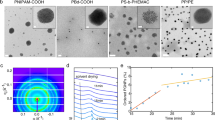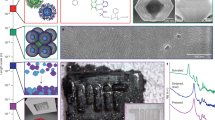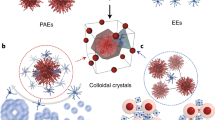Abstract
Crystallization is a fundamental and ubiquitous process much studied over the centuries. But although the crystallization of atoms is fairly well understood1,2, it remains challenging to predict reliably the outcome of molecular crystallization processes that are complicated by various molecular interactions and solvent involvement. This difficulty also applies to nanoparticles: high-quality three-dimensional crystals3,4,5,6 are mostly produced using drying and sedimentation techniques that are often impossible to rationalize and control to give a desired crystal symmetry, lattice spacing and habit (crystal shape). In principle, DNA-mediated assembly of nanoparticles offers an ideal opportunity for studying nanoparticle crystallization7,8,9,10,11,12,13,14,15,16,17: a well-defined set of rules have been developed to target desired lattice symmetries and lattice constants8,9,18, and the occurrence of features such as grain boundaries and twinning in DNA superlattices and traditional crystals comprised of molecular or atomic building blocks suggests that similar principles govern their crystallization. But the presence of charged biomolecules, interparticle spacings of tens of nanometres, and the realization so far of only polycrystalline DNA-interconnected nanoparticle superlattices, all suggest that DNA-guided crystallization may differ from traditional crystal growth. Here we show that very slow cooling, over several days, of solutions of complementary-DNA-modified nanoparticles through the melting temperature of the system gives the thermodynamic product with a specific and uniform crystal habit. We find that our nanoparticle assemblies have the Wulff equilibrium crystal structure that is predicted from theoretical considerations and molecular dynamics simulations, thus establishing that DNA hybridization can direct nanoparticle assembly along a pathway that mimics atomic crystallization.
This is a preview of subscription content, access via your institution
Access options
Subscribe to this journal
Receive 51 print issues and online access
$199.00 per year
only $3.90 per issue
Buy this article
- Purchase on Springer Link
- Instant access to full article PDF
Prices may be subject to local taxes which are calculated during checkout




Similar content being viewed by others
References
Wulff, G. On the question of speed of growth and dissolution of crystal surfaces. Z. Krystallogr. Mineral. 34, 449–530 (1901)
Xia, Y. N., Xiong, Y. J., Lim, B. & Skrabalak, S. E. Shape-controlled synthesis of metal nanocrystals: simple chemistry meets complex physics? Angew. Chem. Int. Edn 48, 60–103 (2009)
Rupich, S. M., Shevchenko, E. V., Bodnarchuk, M. I., Lee, B. & Talapin, D. V. Size-dependent multiple twinning in nanocrystal superlattices. J. Am. Chem. Soc. 132, 289–296 (2010)
Compton, O. C. & Osterloh, F. E. Evolution of size and shape in the colloidal crystallization of gold nanoparticles. J. Am. Chem. Soc. 129, 7793–7798 (2007)
Kalsin, A. M. et al. Electrostatic self-assembly of binary nanoparticle crystals with a diamond-like lattice. Science 312, 420–424 (2006)
Wang, T., LaMontagne, D., Lynch, J., Zhuang, J. Q. & Cao, Y. C. Colloidal superparticles from nanoparticle assembly. Chem. Soc. Rev. 42, 2804–2823 (2013)
Mirkin, C. A., Letsinger, R. L., Mucic, R. C. & Storhoff, J. J. A DNA-based method for rationally assembling nanoparticles into macroscopic materials. Nature 382, 607–609 (1996)
Macfarlane, R. J., O'Brien, M. N., Hurst, S. J. & Mirkin, C. A. Nucleic acid-modified nanostructures as programmable atom equivalents: forging a new “table of elements”. Angew. Chem. Int. Edn 52, 5688–5698 (2013)
Macfarlane, R. J. et al. Nanoparticle superlattice engineering with DNA. Science 334, 204–208 (2011)
Auyeung, E. et al. Synthetically programmable nanoparticle superlattices using a hollow three-dimensional spacer approach. Nature Nanotechnol. 7, 24–28 (2012)
Jones, M. R. et al. DNA-nanoparticle superlattices formed from anisotropic building blocks. Nature Mater. 9, 913–917 (2010)
Park, S. Y. et al. DNA-programmable nanoparticle crystallization. Nature 451, 553–556 (2008)
Nykypanchuk, D., Maye, M. M., van der Lelie, D. & Gang, O. DNA-guided crystallization of colloidal nanoparticles. Nature 451, 549–552 (2008)
Cutler, J. I. Auyeung, E. & Mirkin, C. A. Spherical nucleic acids. J. Am. Chem. Soc. 134, 1376–1391 (2012)
Zhang, C. et al. A general approach to DNA-programmable atom equivalents. Nature Mater. 12, 741–746 (2013)
Senesi, A. J. et al. Stepwise evolution of DNA-programmable nanoparticle superlattices. Angew. Chem. Int. Edn 52, 6624–6628 (2013)
Macfarlane, R. J. Jones, M. R., Lee, B., Auyeung, E. & Mirkin, C. A. Topotactic interconversion of nanoparticle superlattices. Science 341, 1222–1225 (2013)
Macfarlane, R. J. et al. Establishing the design rules for DNA-mediated colloidal crystallization. Angew. Chem. Int. Edn 49, 4589–4592 (2010)
Auyeung, E., Macfarlane, R. J., Choi, C. H. J., Cutler, J. I. & Mirkin, C. A. Transitioning DNA-engineered nanoparticle superlattices from solution to the solid state. Adv. Mater. 24, 5181–5186 (2012)
Abrosimov, N. V., Rossolenko, S. N., Thieme, W., Gerhardt, A. & Schroder, W. Czochralski growth of Si- and Ge-rich SiGe single crystals. J. Cryst. Growth 174, 182–186 (1997)
Nagaoka, Y., Chen, O., Wang, Z. W. & Cao, Y. C. Structural control of nanocrystal superlattices using organic guest molecules. J. Am. Chem. Soc. 134, 2868–2871 (2012)
Mackenzie, J. K., Moore, A. J. W. & Nicholas, J. F. Bonds broken at atomically flat crystal surfaces.1. Face-centred and body-centred cubic crystals. J. Phys. Chem. Solids 23, 185–196 (1962)
Sundquist, B. E. Direct determination of anisotropy of surface free energy of solid gold, silver, copper, nickel, and alpha and gamma iron. Acta Metall. Mater. 12, 67–86 (1964)
Li, T. I. N. G., Sknepnek, R., Macfarlane, R. J., Mirkin, C. A. & de la Cruz, M. O. Modeling the crystallization of spherical nucleic acid nanoparticle conjugates with molecular dynamics simulations. Nano Lett. 12, 2509–2514 (2012)
Knorowski, C., Burleigh, S. & Travesset, A. Dynamics and statics of DNA-programmable nanoparticle self-assembly and crystallization. Phys. Rev. Lett. 106, 215501–215504 (2011)
Zwanikken, J. W., Guo, P. J., Mirkin, C. A. & de la Cruz, M. O. Local ionic environment around polyvalent nucleic acid-functionalized nanoparticles. J. Phys. Chem. C 115, 16368–16373 (2011)
Li, T. I. N. G., Sknepnek, R. & de la Cruz, M. O. Thermally active hybridization drives the crystallization of DNA-functionalized nanoparticles. J. Am. Chem. Soc. 135, 8535–8541 (2013)
Che, J. G., Chan, C. T., Jian, W. E. & Leung, T. C. Surface atomic structures, surface energies, and equilibrium crystal shape of molybdenum. Phys. Rev. B 57, 1875–1880 (1998)
Acknowledgements
C.A.M. and M.O.d.l.C. acknowledge support from the following awards: the Air Force Office of Scientific Research (AFOSR) Multidisciplinary University Research Initiative (MURI) FA9550-11-1-0275, the National Science Foundation Materials Research Science and Engineering Center programme DMR-1121262 at the Materials Research Center of Northwestern University, and the Non-equilibrium Energy Research Center (NERC), an Energy Frontier Research Center funded by the Department of Energy (DoE), Office of Science, Office of Basic Energy Sciences under Award DE-SC0000989. E.A. acknowledges a National Defense Science and Engineering Graduate (NDSEG) Fellowship (number 32 CFR 168a). T.L. acknowledges a Ryan Fellowship from Northwestern University. T.L. thanks S. Dhakal and K. Kohlstedt for sharing scripts on the colloid model and S. Patala and J. Zwanikken for discussions. SAXS experiments were carried out at the Dupont–Northwestern–Dow Collaborative Access Team beam line at the Advanced Photon Source (APS) at Argonne National Laboratory, and use of the APS was supported by the DoE (DE-AC02-06CH11357). The electron microscopy work was performed at the Electron Probe Instrumentation Center of the NU Atomic and Nanoscale Characterization Experimental Center at Northwestern University. The computational work was performed using the TARDIS computer cluster supported by the US Department of Defense National Security Science and Engineering Faculty Fellowship (number FA9550-10-1-0167).
Author information
Authors and Affiliations
Contributions
E.A., T.I.N.G.L., A.J.S., M.O.d.l.C. and C.A.M. designed experiments and analysed data. E.A. collected and analysed data for electron microscopy and X-ray studies. T.I.N.G.L. collected molecular dynamics simulation results. T.I.N.G.L. and M.O.d.l.C. wrote the theoretical model and the simulation details found in the Supplementary Information. E.A. and C.A.M. wrote the manuscript. A.J.S., A.L.S. and B.P. prepared samples and collected electron microscopy data.
Corresponding author
Ethics declarations
Competing interests
The authors declare no competing financial interests.
Supplementary information
Supplementary Information
This file contains Supplementary Materials and Methods, a Supplementary Discussion, Supplementary Figures 1-15, Supplementary Tables 1-2 and additional references. (PDF 2574 kb)
MD Simulations of Rhombic Dodecahedra Microcrystal Formation from Coarse-Grained DNA-Nanoparticle Building Blocks
DNA-nanoparticles coarse-grained as a single bead interact with other beads via electrostatic repulsions and complementary sticky end attractions at ~ 0.95 Tmelt. Consistent with experimental observations, a rhombic dodecahedron microcrystal forms gradually over time. (MOV 16744 kb)
MD Simulations of Formation of FCC Superlattice Grains from Coarse-Grained DNA-Nanoparticle Building Blocks
DNA-nanoparticles coarse-grained as a single bead interact with other beads via electrostatic repulsions and complementary sticky end attractions. Consistent with experimental observations, single crystal Wulff shapes are not observed. (MOV 19016 kb)
Rights and permissions
About this article
Cite this article
Auyeung, E., Li, T., Senesi, A. et al. DNA-mediated nanoparticle crystallization into Wulff polyhedra. Nature 505, 73–77 (2014). https://doi.org/10.1038/nature12739
Received:
Accepted:
Published:
Issue Date:
DOI: https://doi.org/10.1038/nature12739
This article is cited by
-
Colloidal quasicrystals engineered with DNA
Nature Materials (2024)
-
Supercrystal engineering of atomically precise gold nanoparticles promoted by surface dynamics
Nature Chemistry (2023)
-
Synthesis of branched silica nanotrees using a nanodroplet sequential fusion strategy
Nature Synthesis (2023)
-
Nanocluster superstructures assembled via surface ligand switching at high temperature
Nature Synthesis (2023)
-
Unravelling crystal growth of nanoparticles
Nature Nanotechnology (2023)
Comments
By submitting a comment you agree to abide by our Terms and Community Guidelines. If you find something abusive or that does not comply with our terms or guidelines please flag it as inappropriate.



